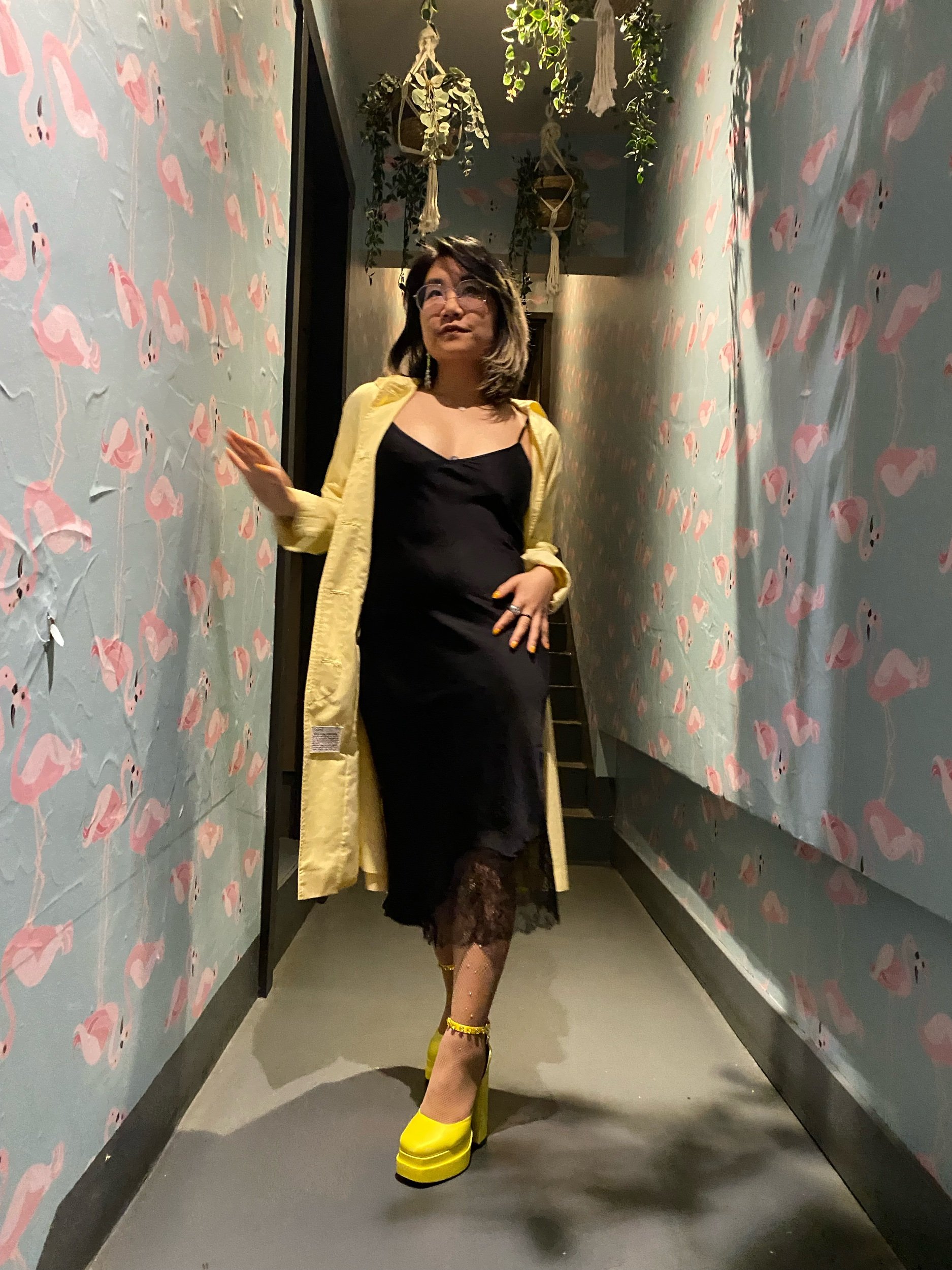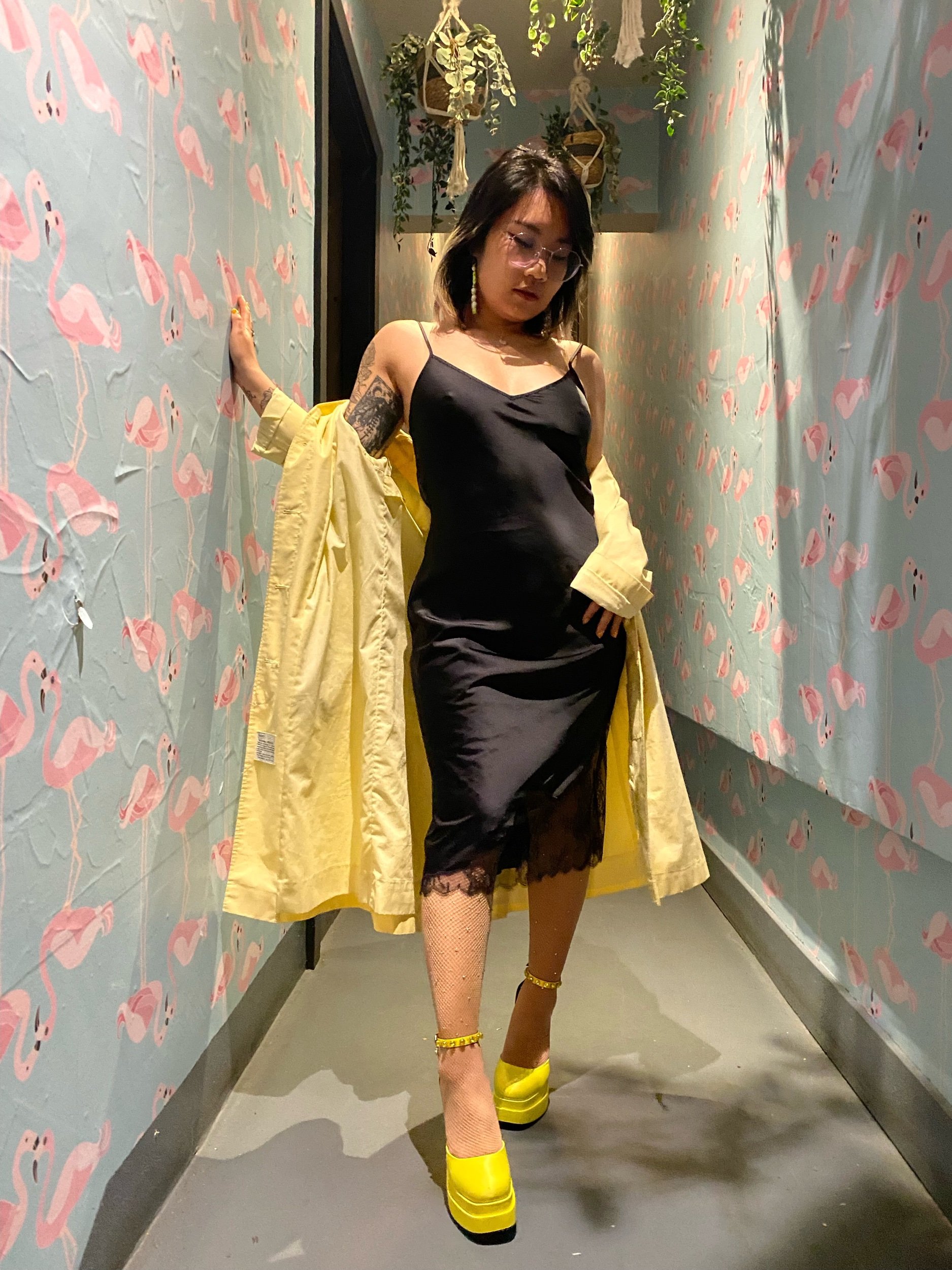On Gender & Feminine Beauty, July 26, 2022
Originally drafted as an Instagram caption to some photos of me dressed up for my birthday. Only putting it here because the full thing doesn’t fit on IG as a caption—sorry this looks a little more self-important than I really intend it to lol.
Ye olde vanity post except I had 1 iced latte today so you get to read my minor breakdown about gender and beauty that came out of me when I was trying to post this like 7 hours ago:
I told my aunt about how bad these shoes hurt and she just said oh yeah but after you wear them out the first time they’ll stop hurting. Practical advice, from a beautiful woman who, for better or for worse, really knows what she’s talking about. And I really do like these shoes.
I’ve been thinking a lot lately about how alluring a merciless sort of devotion to beauty and personal style is. I’ve somehow circled back to glorifying beauty-is-pain/power. Or maybe because I was not a beautiful teenager and embraced a “not like other girls” mentality when that was the thing to do, I’m only just coming around to this now? And I thought maybe it could be different if I called it queer rather than acknowledge it to be a patriarchal thing but who am I kidding.
I’ve also been thinking a lot lately about what gender-affirming presentation means to me as a woman. This partially stems from seeing hot-takes about how cis people also get gender-affirming surgeries/medical interventions all the time. This is meant to illustrate how the same procedures for trans people are discriminated against because of transphobia. My takeaway isn’t that “gender-affirming” is simple and good and applicable to everyone always, but rather that gender(ed appearance, behaviour, etc.) is just pretty unstable and artificial for everyone all the time, oftentimes requiring maintenance and performance, even if you are cis.
The definition of chemically unstable (as pulled from Wikipedia lol): “the material is said to be unstable if it can corrode, decompose, polymerize, burn or explode under the conditions of anticipated use or normal environmental conditions.” You don’t have to be trans, genderqueer, or a woman to experience gender as corrosive or about to explode in “normal environmental conditions”. In my case, as a woman, I am only too familiar with the feeling of grappling with an uneasy pleasure or pleasurable ease of playing into feminine beauty. It feels good to make myself pretty, but being pretty—specifically in public, where I’m at the mercy of the lowest common dirtbag denominator—can also feel corrosive to my sense of self and personhood. (I know this is an entirely unoriginal thought; so much of patriarchy is literally about infantilizing, dehumanizing, and objectifying women. Even more so if you are a racialized woman or a trans woman.) Going against the grain—such as by embracing masculinity or rejecting beauty altogether—is its own form of decomposition, which can be generative and liberating, but also deeply challenging and destabilizing. Transforming oneself, whether to embrace or to reject feminine beauty, is an innately artificial and alchemical process. But what exactly am I turning into?
Sometimes I find myself watching romcoms and longing for the stability of knowing what role I am meant to play and wishing that in real life, as in the conventions of such films, physical transformation and beautification always portends profound and true personal growth. But in reality, I don’t know at what point I ought to stop “affirming my own gender” from within the narrow confines of femininity that ascribe the utmost value and definition of my gender to being beautiful and desirable to men. And if we are uncritical about how we apply queer concepts of gender affirming presentation (i.e. in my case, as a cis woman), we risk ending up with a rainbow-washed version of neoliberal #girlboss absolute individual choice, wherein merely stating that I wear pretty and painful shoes “for me”—or, in the rainbow remix of this tune, “for the girls & the gays”—is enough to transmute it into a radical, feminist act. It is not.
Merely existing but especially being perceived under dehumanizing conditions that remain the norm (the so-called “normal environmental conditions”) catalyzes reactions in and around me to which I do not consent, am sometimes not even aware of, but am nevertheless always subject to. We live in a society, and I unfortunately also have to live inside my own head, as do you in yours. Neither of us are probably okay. This is part of why I find posting posed photos of myself so difficult and dysphoric these days, even on my “private” Instagram, which is really not so private when you consider all the possible ways you can be perceived by 400 individual people. It feels like I am inviting an infinite kaleidoscope of perception and misperception—however fleeting or hidden from me. Reactions upon reactions, combusting like a never ending firecracker. Maybe I just want to use Instagram as a semi-private catalogue of happy moments, like this one where I was in the safe company of my partner, celebrating my birthday, feeling pretty in my own body with someone I choose to share it with. I wish I could control and contain all these reactive substances (not just who follows me, but their ways of looking on any given day at any given image of me) somehow, but I know I can’t.
So the so-called “normal environmental conditions” are not so normal after all, not online, not offline. Not when you perceive me, not when I perceive you. Or maybe we should no longer accept present conditions as normal or any single normal at all.
To this end, l’m very grateful to my trans & non-binary friends for modeling queer-as-in-being-at-odds (to quote bell hooks). Because of all of the many many ways trans and genderqueer existence flout normativity and embrace instability, I am learning to feel okay steeping in the instability of my own gendered existence too.


